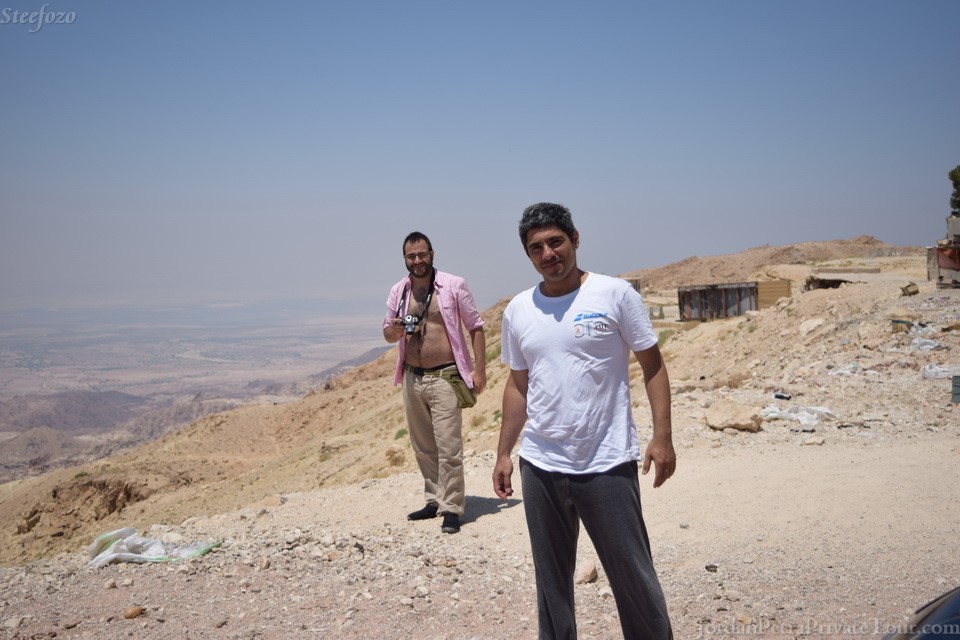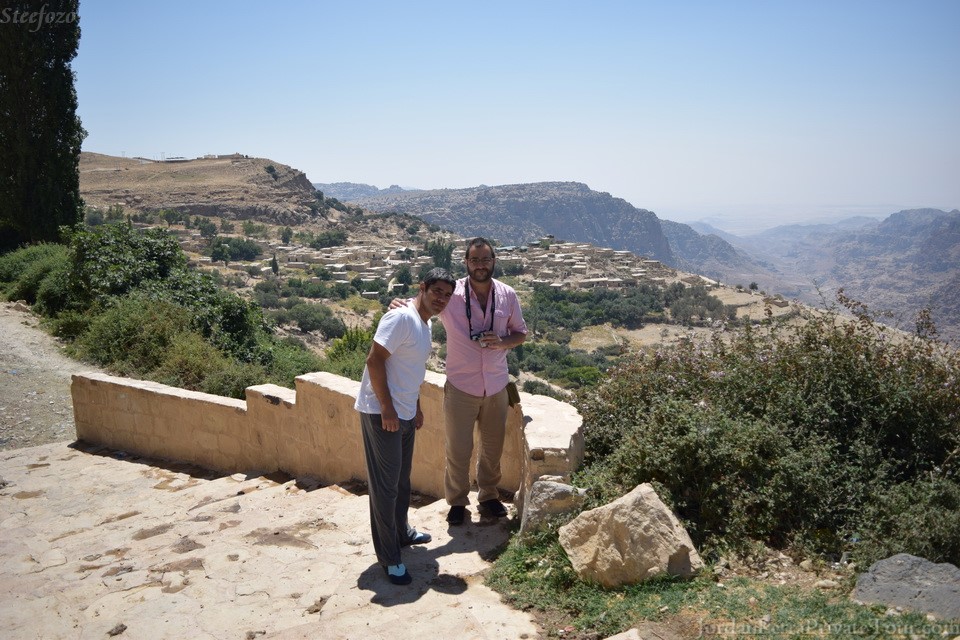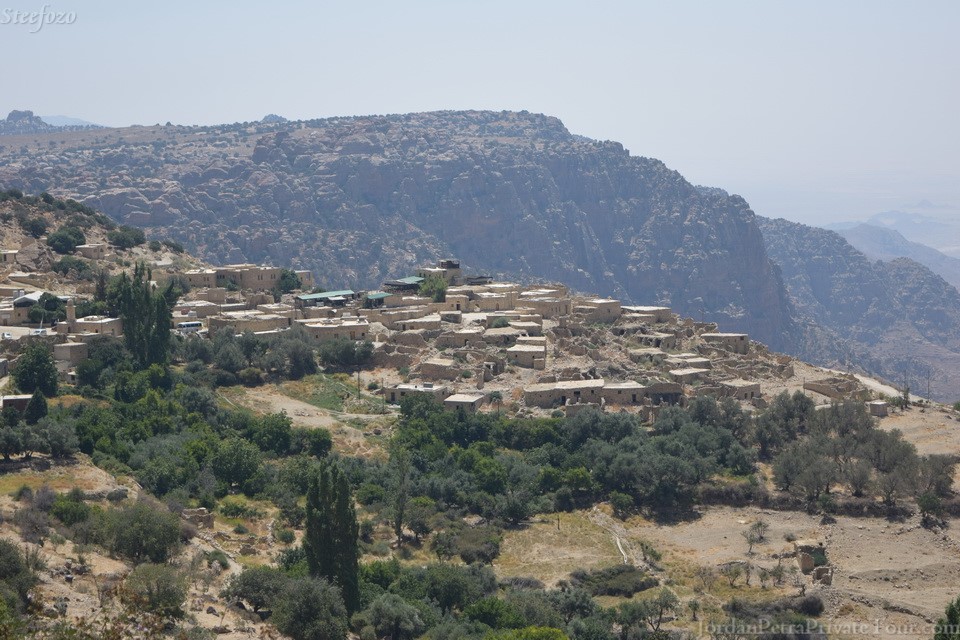Victor Gonzalez and Paulo, arrived to Jordan on Mar 14th, 2014 and started Jordan - Wadi Rum - Dana - Al-Karak - Dead Sea Two Days Private tour, we started early morning, leaving from Amman through Dead Sea – Jordan valley way toward Dana Natural reserve.
The first stop on the way was at the Dead Sea : The Dead Sea Located in the Jordan Valley, part of the Great Rift Valley that runs from East Africa to Turkey, the Dead Sea is the remains of a giant inland lake. Lake Lisan was 200 kilometers long and approximately 200 meters deeper than the current level of the Dead Sea. As it contracted, it left Lake Tiberias and the Dead Sea, which at 408 meters below sea level is the lowest point on earth.
Near the northern end of the Sea, the waters of the Jordan River trickle into the Baptism Site, which may also be where the prophet Ilyas ascended to heaven in a whirlwind. Nearby are the Mountains of Moab and Mount Nebo, where the prophet Moses first saw the Promised Land, famously overlooking the Dead Sea. Mukawir, or Herod s Palace, also has a spectacular view.
The Dana Reserve is possibly the best known of Jordan s nature reserves. This showplace, set up in 1993, has become an exemplar of how to set up a sustainable, ecofriendly reserve. With its network of guided and unguided hiking trails, it s campground, guesthouse and eco-Lodge with their staffs of residents, its dramatic wadis and mountains dropping about 1600 meters from the highest point, there are 320 square kilometers full of things to do and marvel at. Most surprising is not the Nabatean tomb, but the sea urchin fossils, now so far from the sea! Dana s unusual mushroom-shaped rock formations captivate the eye. Visitors will leave the reserve with an appreciation of the tectonic forces that shaped this region.
Dana has been inhabited since approximately 4000 BC There is evidence to suggest that Paleolithic peoples, Egyptians, Nabateans and Romans lived here, lured by its strategic location and reliable fresh water sources. Dana Village is now experiencing something of a rebirth, as the economic opportunities offered by RSCN and the "Friends of Dana" group allow the residents to rebuild their stone houses and remain here, rather than moving away from their families to find work. A unique opportunity arose recently when an Italian filmmaker chose Dana Village as the site for his movie. The village was first built about 400 years ago by members of the AI-Ata ata tribe.
Within Dana reserve, there are restricted areas where Bedouin families from the Azazmeh, Amareen and Sa idyeen tribal groups graze their livestock. Bedouin graves were often made with local juniper wood, as its distinctive scent kept away the hyenas, the largest predator in the reserve. Juniper wood was also used for tent poles, and the berries for tea.
Some of the animals in Dana reserve are truly unique. The Caracal cat is such a great jumper that it can catch birds in midair. 80% of the world s population of Tristan s Serin, a small finch found only in the Middle East, lives in Dana. It is not uncommon for visitors to be serenaded at night by grey wolves, as at least three packs live within Dana.
Next we continue moving toward Wadi Rum : Wadi Rum Falling approximately 600 meters from the high plateau of Ras an-Naqab, Wadi Rum stretches 2 kilometers by 130 kilometers. This series of valleys covered in softly colored sand, punctuated by huge, imposing, fantastically shaped jebels, is one of the most memorable destinations in Jordan, and has been so since the dawn of time. Deep in the valleys, far from any visible human habitation, it is possible to believe the view has not changed much since the beginnings of human habitation in the Valley of the Moon, approximately 800 Be. T.E. Lawrence, the legendary Lawrence of Arabia, came here many times, both in his pursuit of success during the Great Arab Revolt of 1917-1918, but also because he found solace in the isolation of Wadi Rum. Rum still rewards visitors today with peace and unceasing beauty.
The magnificence of Rum lies primarily in its amazing geology. The same tectonic forces which created the Great Rift Valley, which runs from Turkey through the Jordan Valley and Wadi Arabah into the Red Sea, sculpted Wadi Rum, tossing layers of sandstone and granite into giant, twisted formations. The fault lines in Rum generally lie NNE-SSW, parallel to those in Wadi Arabah, but they are cut by counter faults which lie NE-SW, NWSE, E-W and N-S. Jebel Rum, the highest second-highest point in Jordan, is 1,754 meters above sea level, looking warily at Jebel Um Ishreen across the wadi, standing only one meter less at 1,753 meters above sea level.
Underneath the floors of the wadis, which lie between 900-1000 meters above sea level, is pre-Cambrian granite, created two billion years ago. In the sandstone strata of the jebels, it is possible to read the geologic history of the area. Red is Cambrian, pale grey is Ordovician, and whitish is Silurian. Separating them are layers of quartz, shale and conglomerates. The weather has shaped them, creating formations like birthday cakes, mushrooms, melting wax, archways and even one that looks like a giant face in profile. The springs that appear throughout Wadi Rum were created when ancient rainfall permeated the sandstone, was stopped by the granite, and found tiny fissures to form pools.
Paleolithic man lived in Wadi Rum, taking advantage of the abundant wildlife and the plentiful springs. Eventually, their life of constant wandering gave way to the Neolithic lifestyle, which introduced agriculture and animal husbandry. The Nabateans made Wadi Rum one of their major settlements outside of Petra. They built three dams in the area, and the remains of their aqueducts are still visible in certain locations. Other visitors to the area left their marks in messages scrawled on the rocks, ranging from Nabatean script to Minaean commentary. The Thamuds, a tribe from what is today Saudi Arabia, left the largest number of inscriptions, from signatures to religious exhortations to messages of love.
The first mention of Wadi Rum was possibly as "Aramaua" in Ptolemeus Geography. It is referred to as "Ad" in the Koran, according to some scholars. Wadi Rum was popular with travelers because of its abundance of food and water, making travel and trading easier, as well as its proximity to Petra, by far the largest urban center in the region. T.E. Lawrence took advantage of these same characteristics during the Great Arab Revolt, during guerilla attacks on the Hejaz Railway.

While wildlife populations have decreased over the years at Wadi Rum, patient visitors can still find animals and birds. Many animals are nocturnal, such as the hyrax, fennec foxes, gerbils and the Arabian sand cat. Ibex and Gazelle herds still exist, and Oryx have been reintroduced into Rum through the RSCN breeding program at Shaumari Reserve. In the evenings, it is possible to hear the musical howls of wolves. Vultures and eagles, as well as the smaller Sinai rose finches and crested larks, populate the area, as well as the ubiquitous snakes, scorpions, and camel spiders.
Hiking and camping opportunities dot the region. The visitor s center near Rum Village is a good place to start a visit. There is a small fort here, part of the chain built by Glubb Pasha to house the Desert Patrol. Hot air ballooning is one of the most dramatic ways to see Wadi Rum, but guided jeep tours are also possible. The most traditional way to experience Wadi Rum, however, is by camel. The stillness, broken only by the wind, the groans of the camels and the sibilant commands of the guides, is phenomenal, with visits to the Burdah Rock Bridge, the five kilometer long Barrah Siq, the Red Sands or the Seven Pillars of Wisdom easy to arrange.
A visit to Wadi Rum is a destination, and there is little that is more quintessentially Jordanian. T. E. Lawrence described Rum as "landscapes in childhood s dreams were so vast and silent," in The Seven Pillars of Wisdom. The Nabateans made it a major center. During the Arab Revolt, it was a site for attacks on the Ottoman Hejaz Railway. Annie Leibovitz photographed King Hussein and Queen Noor among the jebels. The Arabian Oryx has been reintroduced into the wild here. The peace and tranquility of the desert, with its amazingly sculpted sandstone jebels, haunt the memory.
Next day, after taking the Jeep tour in Rum Valley, we moved ahead toward Al-Karak Castle : The enormous Crusader castle of Karak looms about 1000 meters above the Dead Sea Valley, a strategic link in the vital communication and protection system of castles that spread from Aqaba to Turkey. Karak was on the trading route between Egypt and Syria during biblical times, and later civilizations also recognized the advantages of the location. The castle has known happiness, but it has also known cruelty. Modern visitors will enjoy the spectacular views and the sandwiched layers of history.
During biblical times, Karak, known then as Kir, Kir Moab and Kir Heres, was the capital of Moab. The city can be found on the famous mosaic map in Madaba. Later used by the Greeks and Romans, its name was changed to “Charac Moba.”
In the twelfth century, the Crusader King Baldwin I of Jerusalem commissioned Payen the Cupbearer to build the fortress of Karak. It became the capital of the Crusader Oultre Jourdain district, and became rich levying taxes on traders, travelers and agricultural produce. Karak is halfway between Shobak and Jerusalem, and its success helped Jerusalem prosper.
The castle was passed down through the de Milly family, but Baldwin III died when the leper Baldwin IV, his heir, was thirteen. A regent was appointed for him, but he died himself shortly after that, leaving only Lady Stephanie to inherit. While she was one of the richest widows in the Middle East, she found it expedient to marry Renauld de Chatillon, who became infamous for throwing prisoners from the castle s battlements into the valley, a distance of 450 meters, wearing a box on their heads so that they would remain conscious until the end.
Saladin, the Ayyubid Dynasty Sultan, was born c. 1138 in Tikrit, Iraq. He became Sultan in 1174 after the death of Nur ad-Din. After taking Syria, Saladin began to work towards his goal of re-taking Palestine from the occupying Crusader forces. Saladin hated de Chatillon, partially for his cruelty, partially because he disrupted supply lines for the Islamic armies, and partially because he once came within one days march of Mecca and Medina, opening threatening to attack the holy cities. To Saladin, who was known as a cultured, honorable soldier and leader, this behavior was inexcusable.
After de Chatillon broke numerous truces with Saladin, he was eventually caught and executed in 1189. Losing the castle broke the Crusader chain of beacon fires and began their downward spiral in the region.
In the late 13th century, the Mamluk Sultan Beibars renovated the castle, deepened the moat and built the lower courtyard. Beibars was originally a slave, and was so ugly that he was returned to the market because of his looks. Although damaged by an earthquake in 1293, the Ottomans also used the castle, after local fighting in the 1880s forced the Christian inhabitants of Karak to flee to Madaba and Ma an. Peace was restored only after a significant number of troops were stationed in the town.
Crossing over the wooden bridge over the dry moat, visitors enter through the Ottoman s Gate. To the left is the Crusader s Gallery, or the stables, at the end of which is a headless stone carving. Some claim it is Saladin, but as it dates from the 2nd century AD, it is likely a Nabatean carving. To the right are passages containing the kitchens and dining areas, as well as barracks. Coming out into the light, the favorite, dizzying drop of de Chatillon is on the left. Ahead is another set of passages, containing a mosque, a church, a prison and a marketplace. In the distance, Umm al-Thallaga "the Mother of Snows" is visible the mountain that was the biggest defensive threat tc Karak. Here, at the Mamluk keep built in 1260, the defense: were strongest. Down below is the Mamluk courtyard and towers overlooking Wadi Karak, possibly down to the site: of Sodom and Gomorrah.
While the castle is being restored, and much of it is open to visitors, there are still some passages that are off-limits It is tempting to imagine what treasures lie within. With any luck, Karak will give up more secrets to us in the near future.
The best part of my trip to Jordan was, without a doubt, our experiences with Mustafa as per the arrangements for two days to visit Wadi al Mujib Siq trail and overnight camping at Desert Moon in Wadi Rum. Mustafa s assistance prior to, during and after the tour were superb. He is both trustworthy and friendly and goes out of his way to ensure that you get the most of your experience. Do not hesitate to make going with Mustafa an important part of your Jordan travel experience!












